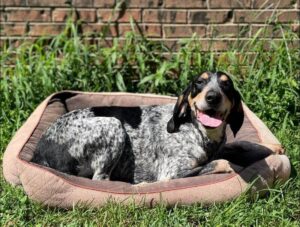
Kacie Davis Jordan | Evenstar-WesRidge Bluetick Coonhounds
Kacie Davis Jordan is the breeder behind Evenstar-WesRidge Bluetick Coonhounds. Read about the kennel’s beginnings, see photos and more!

Home » Dog Breeds » Bluetick Coonhound Dog Breed
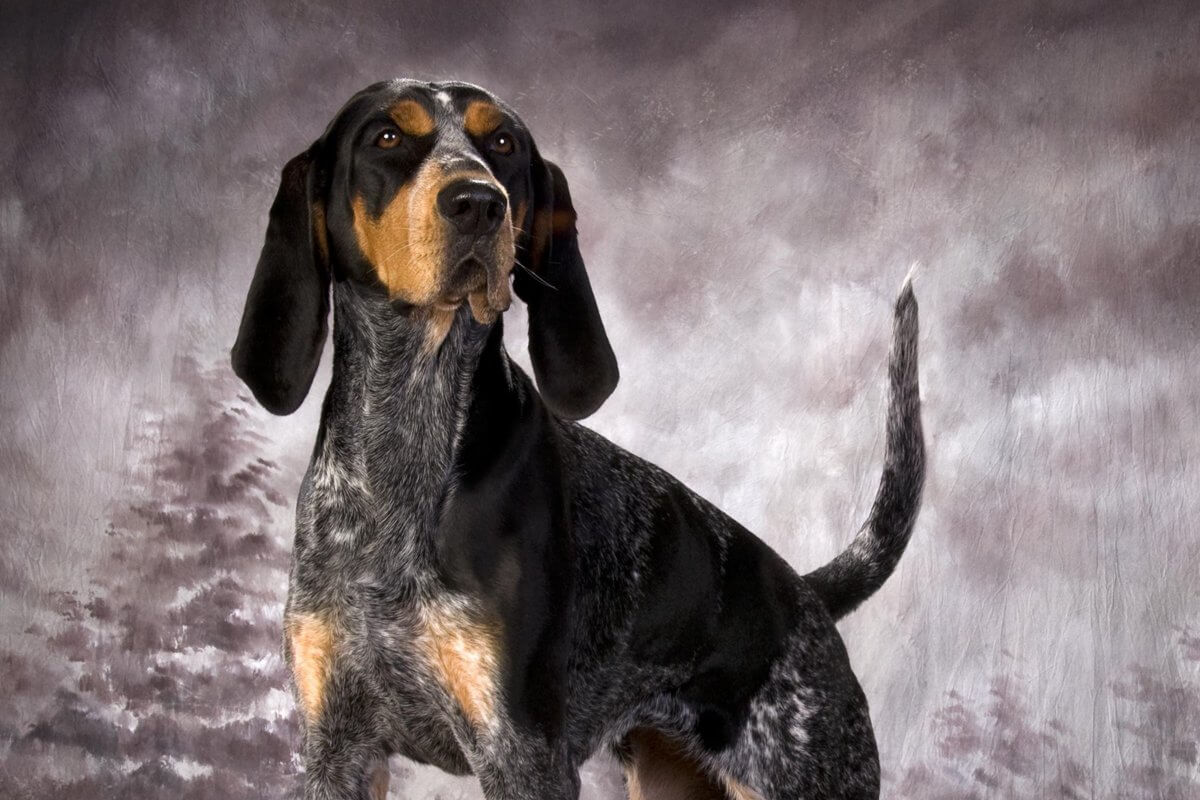
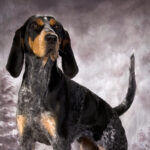
The Bluetick Coonhound is a breed renowned for a striking coat that is marked by a mottled pattern in a deep blue hue. Originating in the United States, the breed is known for its acute sense of smell, which is often considered second only to that of the Bloodhound. These coonhounds are highly energetic and have been used historically for hunting raccoons and other large game animals.
Hound
21 – 27 Inches
45 – 80 Pounds
11 – 12 Years
| Country of Origin | United States |
|---|---|
| Bred For | Raccoon and Big Game Hunting, Companionship |
| Known For | Striking Coat, Sensitivity, Affection, Bugle-Like Voice |
| Popularity | Low to Moderate |
| Temperament | Devoted, Smart, Tenacious |
| Activities | Hunting, Running, Hiking, Nite Hunts, Conformation Shows, Dog Sports |
The history of the Bluetick Coonhound is steeped in American history, tracing its roots back to the early days of the nation’s founding. Originally, the breed descended from the Grand Bleu de Gascogne, a French Staghound, and the English Foxhound. Both of these ancestors were brought to the United States by early immigrants who selectively bred their hounds to adapt to the unique terrain and hunting conditions found in the New World.
The Bluetick was primarily developed in the Southern United States, particularly in parts of Louisiana, Florida, and Tennessee. The early hounds were specifically bred for their keen sense of smell and tireless work ethic. They were considered to be exceptional at tracking raccoons and other wild animals, primarily at night.
Over the years, as hunting practices evolved, so too did the role of the Bluetick. While the hounds continued to be prized for their hunting skills, their pleasant demeanor and striking appearance soon made them popular as companion animals. This was due in no small part to the hounds’ beautifully mottled “blue” coat, which is one of the breed’s distinguishing features.
The American Kennel Club (AKC) initially grouped the Bluetick with the English Coonhound. However, recognizing its unique characteristics and history, the registry officially recognized the Bluetick Coonhound as a separate breed in 2009.
Today, the Bluetick Coonhound continues to be a symbol of American heritage and ingenuity. Whether a hound participates in hunting expeditions, dog shows, or simply lounges at home, it carries with it a rich legacy of tradition and adaptability. The breed’s combination of hunting prowess, loyalty, and affectionate nature ensures these hounds are sure to remain beloved both in the field and in the family home.
Adult males typically stand between 22 and 27 inches tall at the shoulder, while mature females usually range from 21 to 25 inches tall.
In terms of weight, males generally weigh between 55 and 80 pounds, with females weighing slightly less, ranging from 45 to 65 pounds.
The Bluetick Coonhound is a well-proportioned dog with a balanced build. Its bodies is square or slightly longer than it is tall, which provides the flexibility needed for hunting in various environments. The breed has a sturdy frame, suggesting strength without any hint of clumsiness or fragility. The overall appearance showcases a hound with great stamina and endurance, one that is capable of rigorous physical activity.
Texture: The Bluetick Coonhound’s coat is short but dense, offering protection against thick underbrush and inclement weather. It is smooth to the touch and provides an effective barrier against the elements while hunting or working in various terrain.
| Standard Color | |
|---|---|
| Blue Ticked | ee |
| Blue Ticked and Tan | ee |
Markings: Black Spots
A Note About Color: As its name suggests, the Bluetick Coonhound has a thickly mottled, dark blue coloration. The blue appearance is created by black ticking on a white background. More ticking than white is preferred on the body, and fully a mottled blue body is preferred over light ticking. The head and ears are predominantly black, with black spots appearing variously on the hound’s back and sides. Tan markings may appear over the eyes and on the cheeks, chest, and below the tail. No other colors are acceptable in this coonhound breed.
The Bluetick Coonhound’s tail, often referred to as the “stern,” is set slightly below the natural line of the back. It is strong at the base and tapers to a fine point. The tail’s length extends to the hocks when the dog is standing in a relaxed posture. When the hound is in motion or particularly alert, the tail is carried high but should never curl over the back.
The tail is covered with a smooth coat and mau occasionally display a slight brush. Due to its length and its strength, the tail can be a good indicator of the hound’s mood, often wagging enthusiastically when the Bluetick is happy or excited.
When bringing a Bluetick Coonhound into the home, it’s essential to understand the breed’s unique characteristics, needs, and potential challenges. Blueticks are energetic, intelligent, and dedicated dogs that, when properly trained and cared for, can make fantastic companions for the right families.
Bluetick Coonhounds are generally hardy and healthy dogs, but like all breeds and mixed breeds, they are susceptible to certain health conditions. Regular veterinary check-ups, a balanced diet, and consistent exercise can help to foster a long and healthy life for the new family member.
Lifespan: On average, Blueticks have a life expectancy of 11 to 12 years. Factors that can influence their lifespan include genetics, health care, diet, and overall lifestyle.
While Bluetick Coonhounds are generally robust and active dogs, they are not immune to certain health concerns. It’s crucial for prospective and current owners to be aware of potential health risks to encourage the dog’s well-being and longevity. Here are some of the common health issues associated with the breed:
Regular vet check-ups are essential to detect potential health issues early on. It’s also beneficial for owners to have their Bluetick Coonhounds tested for common hereditary conditions, even if the hounds don’t show immediate symptoms. Prevention, timely detection, and appropriate care are necessary to provide every Bluetick with the chance to live a long, healthy, and active life.
The Bluetick Coonhound is more than just striking in appearance; it possesses a distinctive personality that sets it apart from similar breeds of scent hounds. Renowned for its keen senses and hunting prowess, the demeanor of a Bluetick at home can be quite different from the hound that’s in working mode.
When considering the suitability of Blueticks for novice owners, it’s worth noting that while these hounds are friendly and loyal, they might pose challenges for those unfamiliar with responsible dog ownership. The hounds’ high energy levels combined with their intelligence necessitate an owner who understands canine behaviors and remains consistent with training.
The typical Bluetick Coonhound has a sensitive nature. It responds best to positive reinforcement and can become withdrawn or anxious if subjected to harsh corrections. Therefore, a gentle yet firm approach is recommended in handling and training these active hunting hounds.
Regarding their tolerance for being alone, this breed can manage solitude for limited periods. However, like most dogs, prolonged isolation can result in unwanted behaviors or signs of anxiety. Blueticks are happiest when included in family activities or given regular tasks to perform.
Bluetick Coonhounds typically get along well with other dogs, especially if they’ve grown up together. Their hunting background endows them with a pack mentality, making them sociable with fellow canines. Moreover, they generally exhibit patience and playfulness with children, although it’s always a good practice to supervise interactions, especially with younger kids.
While they are usually friendly with dogs they are familiar with, Blueticks can be initially wary of strangers. Early and continuous socialization helps them to differentiate between a friend and a potential threat, but a certain degree of caution towards unfamiliar faces might always be present in this active and intelligent coonhound.
Feeding a Bluetick Coonhound requires an understanding of the breed’s specific needs throughout its life stages. Given their energetic nature, these dogs benefit from high-quality, nutritionally balanced food to fuel their active lifestyles.
For Bluetick puppies, it’s crucial to provide a diet that supports their rapid growth and development. Puppy-specific formulations usually have the required nutrients and calorie content to cater to their needs. As they transition to adulthood, the dietary requirements change, and feeding them adult-specific formulations becomes essential.
The amount of food a Bluetick Coonhound requires can vary based on factors such as age, activity level, metabolism, and overall health. On average, an adult Bluetick may consume 2 to 2.5 cups of high-quality dry food per day, divided into two meals. However, this is just a guideline, and it’s essential to monitor the dog’s weight and adjust portions as needed to prevent overfeeding or underfeeding.
It’s worth mentioning that individual dietary needs can vary widely even within the same breed. Therefore, regular vet consultations are advisable to ensure the nutritional requirements of an individual coonhound are being adequately met.
Water is another essential aspect of the Bluetick’s diet. It’s always important to provide constant access to fresh, clean water, especially after intense activity and throughout the months of hotter weather and increased humidity.
When it comes to giving treats, moderation is key. While treats can be a valuable training tool, over-reliance or overindulgence can lead to weight gain and other health issues. Always opt for healthy treat options and consider them as a part of a Bluetick Coonhound’s overall daily calorie intake.
Training a Bluetick Coonhound presents a unique blend of challenges and rewards. This breed, with its hunting lineage, combines intelligence with a high degree of determination. Recognizing and tapping into these traits can be the key to a successful training experience.
Blueticks are smart and they’re often quick learners. However, their independent streak might sometimes be perceived as stubbornness. It’s essential for trainers, especially those new to the breed, to approach training with a mix of patience, consistency, and positive reinforcement. This coonhound responds far better to encouragement and rewards than to harsh corrections.
One aspect that potential owners should be prepared for is the breed’s vocal nature. The Bluetick Coonhound is known for its distinctive bay, which can be loud and frequent. Training these hounds from a young age about when it’s appropriate to voice their opinions can be beneficial, though it might be challenging to completely suppress this natural instinct.
The hunting instincts of the Bluetick also influence this dog’s behaviors. These hounds have a strong prey drive, which means they might have a tendency to chase after smaller animals. Early socialization and exposure to various situations, animals, and environments can help in curbing unwanted chasing behaviors.
Another point to note is the Bluetick Coonhound’s penchant for wanderlust. Thembreed’s keen nose can lead these dogs to pursue fascinating scent trails, making it essential to train reliable recall commands. Providing secure fencing, and always using a leash during walks, can prevent those unscheduled adventures.
The Bluetick Coonhound is an energetic and active purebred, with a rich history rooted in hunting and tracking. Therefore, it’s no surprise that this hound has significant exercise needs to maintain its physical and mental well-being.
| Energy Level | Medium-High |
|---|---|
| Exercise Requirements | 1 Hour/Day (Minimum), Daily Walks, Vigorous Running, Regular Exercise, Playing with Another Dog, Mental Stimulation |
The breed thrives on regular physical activities, which not only provide an outlet for its energy but also cater to each hound’s innate instincts. Daily walks, ranging from moderate to long in duration, are essential to keep a Bluetick happy. These excursions serve as an excellent opportunity for coonhounds to explore new scents and environments, satisfying their natural curiosity.
However, mere walks might not suffice for this spirited breed. They also benefit from regular play sessions, where they can freely run and engage in activities that challenge them mentally. Fetch, hide and seek, and scent tracking games can be particularly fun for them. A securely fenced yard where they can roam and play safely can be a boon for coonhound owners.
It’s worth noting that, due to the Bluetick Coonhound’s strong prey drive, these hounds might be inclined to chase after smaller animals. This makes it imperative to have them on a leash during walks, especially in unfamiliar or wildlife-rich areas.
While the Bluetick is robust and can have high-intensity play sessions, it’s equally important to recognize when these dogs need rest. Over-exertion, especially in hot weather, can be harmful. It’s important to always ensure they have access to fresh water during and after strenuous exercise sessions.
The energy level of a Bluetick Coonhound is quite consistent, showing moderate to high intensity levels. This breed is also notably playful, which can be leveraged during training sessions to make any activity more engaging and effective.
Bluetick Coonhounds, with their sleek and smooth coat, may give the impression of being low-maintenance from a grooming perspective. While they certainly aren’t as demanding as some long-coated breeds, these hounds do have specific grooming needs that owners should be aware of.
| Coat Type | Medium Coarse, Smooth, Glossy |
|---|---|
| Grooming Requirements | Weekly Brushing, Monthly Bathing, Routine Ear Cleaning, Periodic Nail Trimming, Regular Tooth Brushing |
The coat of a Bluetick Coonhound is indeed short, but it is dense enough to offer protection during their outdoor escapades. This coat type does shed, though not excessively so. Regular brushing, ideally once a week, will help to remove loose hairs and maintain the coat’s natural sheen. A firm-bristled brush is typically effective for this task, as it can easily reach through the dense coat and remove debris and dead hair.
While they don’t require frequent baths, it’s a good idea to give the Bluetick a thorough wash every few months or whenever the hound gets particularly dirty. The breed’s adventurous nature will likely mean the occasional encounter with muddy puddles and other messy environments. Bathing, when necessary, should always include a dog-specific shampoo that’s gentle on the hound’s skin.
Ear care is crucial for the Bluetick Coonhound. The breed’s floppy ears can trap moisture and debris, making them susceptible to infections. It’s advisable to check the hound’s ears regularly for signs of redness, bad odor, or excessive wax. Gently cleaning them with a vet-approved solution can prevent many common ear issues from becoming chronic problems.
The coonhound’s nails should also be trimmed regularly. If they get too long, they can cause discomfort and even lead to injuries. For those not comfortable with trimming their dog’s nails, seeking the help of a professional groomer or veterinarian is a wise decision.
Lastly, dental care is essential for every Bluetick Coonhound. Regular brushing of the teeth can prevent tartar buildup and avoid dental diseases. If the dog is resistant to toothbrushing, dental chews or professional cleanings can be good alternatives.
Living with a Bluetick Coonhound is a unique experience that can be both challenging and rewarding. Understanding the breed’s characteristics and catering to the hound’s needs can make cohabitation harmonious for every member of the household.
When it comes to housing, while a Bluetick can adapt to apartment living, it’s not the ideal environment for this energetic scent hound. Given the breed’s origins as a hunting dog and its subsequent energy levels, these dogs thrive best in homes with spacious yards where they can roam, play, and follow intriguing scents at their leisure. If an apartment lifestyle is expected, it’s crucial to ensure the coonhound receives ample exercise and outdoor time to prevent restlessness and potential behavioral issues.
Temperature sensitivity is another point to consider. Bluetick Coonhounds are hardy and can generally tolerate a range of temperatures. However, they’re more suited to moderate climates, thanks to their dense coat. In particularly hot weather, it’s vital to provide them with shade and plenty of water, and to avoid intense physical activity during the hottest parts of the day.
In contrast, these hounds fare relatively well in colder conditions, but it’s always a good idea to monitor them and provide a warm shelter if temperatures drop significantly.
Blueticks have strong hunting instincts, which means they might occasionally be prone to wandering off if they pick up an interesting scent. This tendency makes it crucial to have secure fencing if there’s a yard for them to spend time in. It also underscores the importance of leash-walking these hounds when outside enclosed areas.
In terms of family dynamics, Bluetick Coonhounds are generally good-natured and can get along well with children and other pets, especially if introduced and socialized from a young age. Their playful nature can make them a hit with kids, though it’s always recommended to supervise interactions between any dog and young children.
The arrival of Bluetick Coonhound puppies can be an exciting time for prospective dog owners. These little bundles of joy, with their soft blue-ticked coats and dark eyes, are sure to melt hearts. However, just as with any puppy, Bluetick babies come with their own set of needs and responsibilities. Making sure their early days are filled with proper care, love, and guidance can pave the way for a well-adjusted adult dog.
When a Bluetick Coonhound puppy is first brought home, one of the primary considerations is the little one’s nutritional needs. Feeding the pup a balanced, high-quality puppy formula is crucial for its growth and development. It’s always recommended to consult with a veterinarian or the puppy’s breeder to determine the right feeding schedule and portion sizes tailored to the young coonhound’s specific needs.
Socialization is another vital aspect of puppy care. Introducing coonhound pups to various environments, people, and other animals at an early age can help to shape their temperament and ensure they grow up to become well-rounded adults. Regular playdates, puppy classes, and walks can be beneficial in this regard.
Training should also commence from an early age. While Bluetick puppies are intelligent and eager to please, they can also be independent and occasionally stubborn. Establishing a foundation of basic obedience and housetraining from the get-go can make future training endeavors smoother. Using positive reinforcement methods, such as treats and praise, will usually yield the best results.
Physical and mental stimulation is paramount in the development of a young coonhound. Puppies are energetic and curious by nature, so providing them with age-appropriate toys and interactive games can help to channel their energy constructively and keep them mentally engaged.
Finally, regular health check-ups are essential to monitor the Bluetick Coonhound puppy’s growth and catch any potential health issues early on. Vaccinations, deworming, and preventive care should be administered as per a veterinarian’s recommendations.
Bluetick Coonhounds, with their robust stamina and keen nose, are naturally inclined towards activities that challenge both their body and mind. Engaging these hounds in various activities and dog sports not only provides them with the much-needed physical exercise, it also offers a wonderful opportunity for bonding with their handlers.
The Bluetick Coonhound is recognized by the world’s leading registries and kennel organizations, which categorize the breed into a specific Group based on its unique characteristics. This breed is recognized worldwide under the following Group designations:
| Organization | Group Designation |
|---|---|
| AKC (American Kennel Club) | Hound |
| UKC (United Kennel Club) | Scenthound |
| CKC (Canadian Kennel Club) | Not Recognized |
| ANKC (Australian National Kennel Council) | Hounds |
| RKC (The Royal Kennel Club) | Not Recognized |
| FCI (Fédération Cynologique Internationale) | Not Recognized |
The ideal Bluetick Coonhound is described by a Breed Standard that is approved by each of the world’s leading registries and kennel organizations. The Breed Standards for this breed may be found in the following links:
| Organization | Breed Standard |
|---|---|
| American Kennel Club | AKC Bluetick Coonhound Breed Standard |
| United Kennel Club | UKC Bluetick Coonhound Breed Standard |
| Canadian Kennel Club | Not Recognized |
| Australian National Kennel Council | ANKC Bluetick Coonhound Breed Standard |
| The Royal Kennel Club | Not Recognized |
| Fédération Cynologique Internationale | Not Recognized |
Dedicated to the promotion, preservation, and betterment of the Bluetick Coonhound, several clubs and organizations have been established over the years. These clubs play a vital role in maintaining the Breed Standard, providing resources for breed enthusiasts, organizing competitive and social events, and championing the welfare of this American dog breed.
In the United States, the National Bluetick Coonhound Association stands as a premier organization, recognized by the American Kennel Club. The organization’s members work tirelessly to promote the breed by preparing educational materials and offering a series of events for the hounds and their handlers throughout the year.
The Bluetick Breeders and Coon Hunters Association was founded in 1954 by a group of experienced varmint hunters in Arkansas. The founders’ mission was to protect these coonhounds as a distinct breed and to promote their use as hard-driving hunters.
The love and appreciation for the Bluetick Coonhound have led to the establishment of several rescue organizations dedicated to the welfare, rehabilitation, and rehoming of this unique breed. Rescues play a crucial role in offering a second chance to Blueticks that have been abandoned, mistreated, or surrendered for any reason.
In the United States, organizations such as the Bluetick Coonhound Rescue and Coonhound Companions are devoted to rescuing, rehabilitating, and finding loving homes for Blueticks in need. The organization’s volunteers work tirelessly to ensure each dog receives the love, care, and forever home it deserves.
Local shelters and animal rescue organizations occasionally come across a Bluetick Coonhound and provide the dog with care as needed. For those considering bringing a Bluetick into the home, checking with local rescues and shelters can be a rewarding way to offer a loving home to a coonhound in need.
Bluetick Coonhounds are generally not aggressive by nature. They are known for their friendly and sociable temperament, especially when properly socialized from a young age. However, like all breeds, individual dogs may have unique personalities, so early training and socialization are essential to prevent any behavioral issues.
Bluetick Coonhounds can enjoy swimming, though it’s not a universally shared trait among all individuals of the breed. While these hounds aren’t bred specifically for water-related tasks like some other breeds, many Blueticks can learn to appreciate water activities, especially on a hot day. As always, it’s crucial to introduce a dog to water in a safe and controlled environment.
Bluetick Coonhounds typically have a lifespan of 11 to 12 years. With proper care, regular veterinary check-ups, and a balanced diet, some can live even longer. Their overall health and longevity can be influenced by factors such as genetics, diet, exercise, and overall care.
Yes, Bluetick Coonhounds shed. They have a short, dense coat that sheds moderately throughout the year. Regular brushing can help to manage and reduce the amount of hair that’s left behind and to promote a healthy coat.
Bluetick Coonhounds can make excellent family dogs. They are generally affectionate and loyal, and they get along well with children. However, due to their hunting background, Blueticks should always be supervised around small pets and properly introduced to other household animals.
Bluetick Coonhounds are intelligent and eager to please, which can aid in training. However, they can also display a streak of independence or stubbornness at times. Consistent, positive reinforcement-based training methods work best with this breed, and patience is key.
Bluetick Coonhounds have a strong hunting and tracking instinct, which can make them curious enough to chase cats and other small animals. However, if they are raised with felines from a young age and properly socialized, they can coexist peacefully. It’s important to always supervise initial interactions and to be aware of the dog’s body language.
No, Bluetick Coonhounds are not hypoallergenic. They shed, and their dander can trigger allergies in sensitive individuals. Regular grooming and cleaning can help to reduce allergens, but people with severe allergies should consult with an allergist before considering this breed as a household companion.

Kacie Davis Jordan is the breeder behind Evenstar-WesRidge Bluetick Coonhounds. Read about the kennel’s beginnings, see photos and more!
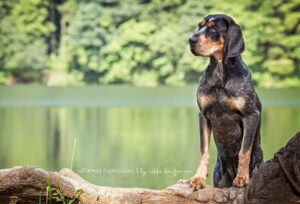
Bluetick Coonhound Color | The Bluetick Coonhound is a beautiful and focused member of the Hound Group. Its essence is found in its
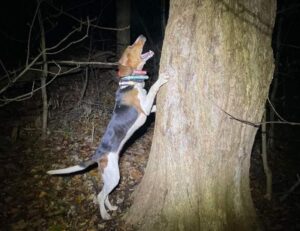
Read and learn about the various coonhound performance events, such as Nite Hunts, Bench Shows, Field Trials, and Water Races.
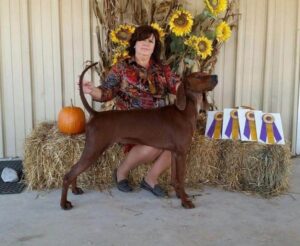
Interview with Hound Group Breeder Lori Mills – My kennel name is Sidearm Kennel. We keep between 40 and 80 dogs, including puppies.
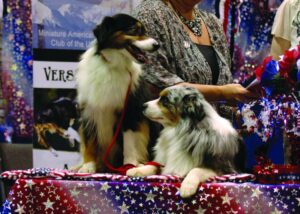
US breeders have produced a number of hearty and hungry canine originals by combining established British, European, and Asian breeds with local village dogs.
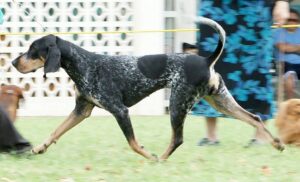
General Appearance of the Bluetick Coonhound | Bluetick Coonhound is a smart and active breed that thrives in an environment where they have
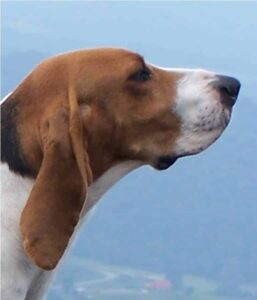
Now that coonhounds are in AKC conformation shows, it is becoming increasingly important that we focus on the correct coonhound structure

Dan Sayers is the Editor-in-Chief of SHOWSIGHT digital and print publications. He received a B.S. from Drexel University where he studied interior architectural design. His professional career has allowed him to develop his planning, problem-solving, and project management skills, which were employed in the office, educational, and financial sectors. While working as a project manager, he earned a Graphic Design Certificate from the University of the Arts and began creating ads for many of America’s top-winning show dogs. Through this work, Dan became Editor-in-Chief of the nation’s first online-only dog show publication. His current role expands on this experience and broadly extends to cover the sport of dogs in Companion and Performance events as well as all aspects of Conformation.
Dan is a long-time member of the Irish Water Spaniel Club of America and is the organization’s current AKC Delegate and Archivist/Historian, as well as a club-approved Breed Mentor. From 2000-2010, he was the club’s AKC Gazette Columnist. He breeds Irish Water Spaniels under the Quiet Storm prefix and has judged the IWSCA National Specialty Sweepstakes twice. Dan is a member of the Morris and Essex Kennel Club as well as the Dog Writers Association of America, which recognized his illustrations in the award-winning canine compendium, the Encyclopedia of K-9 Terminology.

"*" indicates required fields
Showsight Magazine–the world’s most influential purebred dog publication since 1992. Each issue reaches a global audience dedicated to preserving the history and health of purpose bred dogs. Filled with award-winning editorial focused on news and insights from the dog show community, top breeders, handlers, AKC Judges, and more!